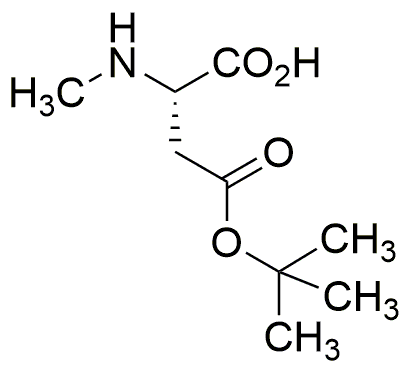N-Methyl-L-aspartic acid b-tert-butyl ester is widely utilized in research focused on:
- Neuroscience Research: This compound serves as a valuable tool in studying neurotransmitter systems, particularly in understanding the role of glutamate receptors in synaptic transmission.
- Pharmaceutical Development: It is used in the synthesis of various pharmaceutical compounds, aiding in the development of drugs targeting neurological disorders.
- Biochemical Assays: The compound is employed in biochemical assays to evaluate enzyme activity and metabolic pathways, providing insights into cellular functions.
- Drug Delivery Systems: Its properties make it suitable for formulating drug delivery systems, enhancing the bioavailability of therapeutic agents.
- Research on Neuroprotective Agents: The compound is explored for its potential neuroprotective effects, contributing to the development of treatments for neurodegenerative diseases.
General Information
Properties
Safety and Regulations
Applications
N-Methyl-L-aspartic acid b-tert-butyl ester is widely utilized in research focused on:
- Neuroscience Research: This compound serves as a valuable tool in studying neurotransmitter systems, particularly in understanding the role of glutamate receptors in synaptic transmission.
- Pharmaceutical Development: It is used in the synthesis of various pharmaceutical compounds, aiding in the development of drugs targeting neurological disorders.
- Biochemical Assays: The compound is employed in biochemical assays to evaluate enzyme activity and metabolic pathways, providing insights into cellular functions.
- Drug Delivery Systems: Its properties make it suitable for formulating drug delivery systems, enhancing the bioavailability of therapeutic agents.
- Research on Neuroprotective Agents: The compound is explored for its potential neuroprotective effects, contributing to the development of treatments for neurodegenerative diseases.
Documents
Safety Data Sheets (SDS)
The SDS provides comprehensive safety information on handling, storage, and disposal of the product.
Product Specification (PS)
The PS provides a comprehensive breakdown of the product’s properties, including chemical composition, physical state, purity, and storage requirements. It also details acceptable quality ranges and the product's intended applications.
Certificates of Analysis (COA)
Search for Certificates of Analysis (COA) by entering the products Lot Number. Lot and Batch Numbers can be found on a product’s label following the words ‘Lot’ or ‘Batch’.
Número de catálogo
Número de lote/lote
Certificates Of Origin (COO)
This COO confirms the country where the product was manufactured, and also details the materials and components used in it and whether it is derived from natural, synthetic, or other specific sources. This certificate may be required for customs, trade, and regulatory compliance.
Número de catálogo
Número de lote/lote
Safety Data Sheets (SDS)
The SDS provides comprehensive safety information on handling, storage, and disposal of the product.
DownloadProduct Specification (PS)
The PS provides a comprehensive breakdown of the product’s properties, including chemical composition, physical state, purity, and storage requirements. It also details acceptable quality ranges and the product's intended applications.
DownloadCertificates of Analysis (COA)
Search for Certificates of Analysis (COA) by entering the products Lot Number. Lot and Batch Numbers can be found on a product’s label following the words ‘Lot’ or ‘Batch’.
Número de catálogo
Número de lote/lote
Certificates Of Origin (COO)
This COO confirms the country where the product was manufactured, and also details the materials and components used in it and whether it is derived from natural, synthetic, or other specific sources. This certificate may be required for customs, trade, and regulatory compliance.


